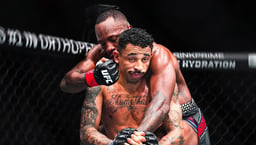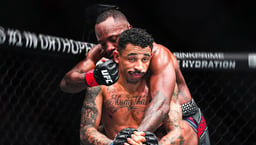
Issue 055
October 2009
Peter Irving is a professional welterweight fighter and Fighters Only’s resident fight expert. With a record of 9-6-1, Irving has fought in Europe and the USA, and currently holds the Strike & Submit European title.
3 Minute Clinic
The grip
The figure-four is entangled around the opponent’s arm, the hand securing the opponent’s wrist is always pushing away, towards the opponent’s back.
Right-angle is the right angle
The arm should be locked out at 90 degrees, any more acute and the opponent will be more flexible. If the angle is more obtuse the opponent will straighten their arm to free themselves from the figure-four.
Position
The kimura can be applied from a variety of positions, but primarily it is seen from the guard and the cross-body position. Here Pete is applying the step-over kimura from side control.
The kimura is known by a variety of names such as chicken wing, ude-garami (in Japanese) and hammerlock. All refer to the figure-four armlock known in Brazilian jiu-jitsu as the kimura, named after Masahiko Kimura, the Japanese judo champion who famously defeated Helio Gracie with this submission in 1951.
The Kimura from Closed Guard
Step 1: Pete is holding Tommy in his closed guard. Pete has a collar tie and Tommy has made the mistake of putting his hand on the mat.
Step 2: Pete starts to sit up and takes wrist control.
Step 3: Pete scoots his butt back, still squeezing his knees and reaches his left arm over to close the figure-four.
Step 4: Pete falls back, escaping his hips to the side of the trapped arm, allowing Tommy a space to fall to the mat.
Step 5: Top view – note that Pete has Tommy’s shoulder pulled in tight to his chest and has Tommy pressed all the way to the mat.
Step 6: From here you can close your guard to finish but, because Tommy is strong, Pete throws his leg right over Tommy’s neck to prevent him posturing up.
The Kimura from Side Control (Step-over Finish)
Step 1: Pete has Tommy pinned in a traditional cross-body hold.
Step 2: Pete switches his base, sitting through under the arm to control the overhooked shoulder.
Step 3: Pete steps over Tommy’s head, pulling up the underhooked arm and trapping the other arm with his leg.
Step 4: Pete lifts the underhook and squeezes his knees together, preventing Tommy from putting his shoulder down on the mat again.
Step 5: Pete locks up the figure-four at 90 degrees, pulling the elbow to his chest and stretching the shoulder girdle.
Step 6: Pete rotates away from his body to finish, maintaining tension upwards as he rotates.
Step 7: It is critical to lock the figure-four on the right side to push rather than pull the arm. Drill both sides until the correct grip becomes automatic. Note that Pete does not use his thumbs to grip the arm.
...









